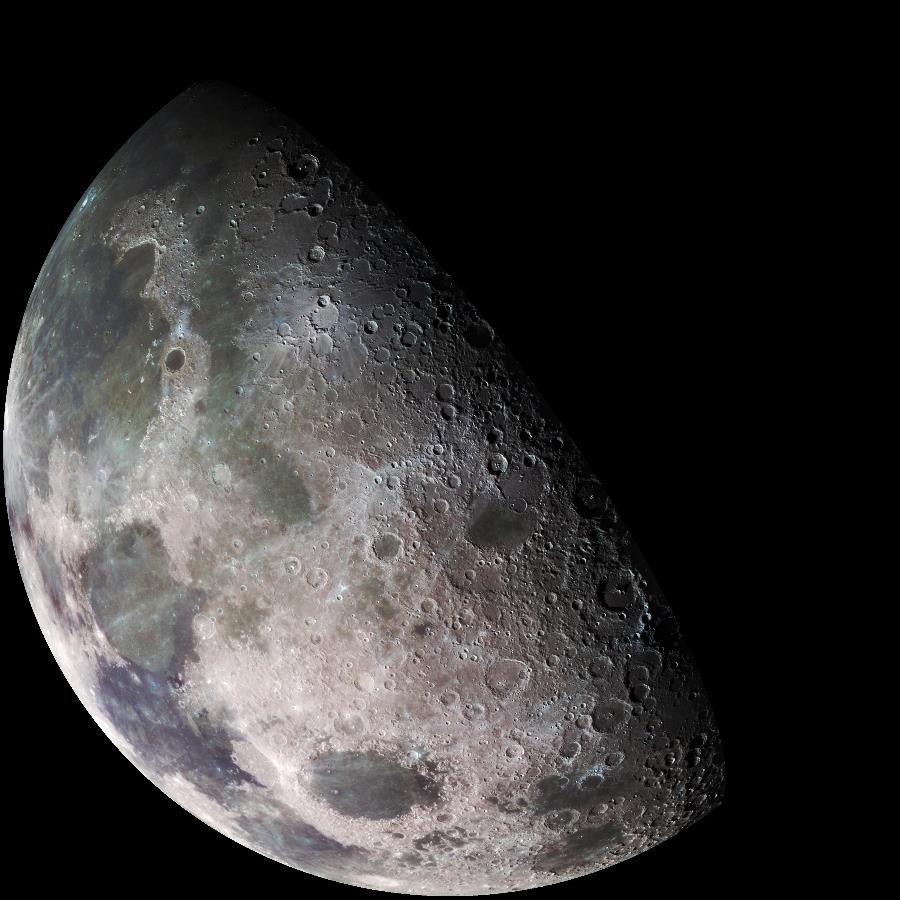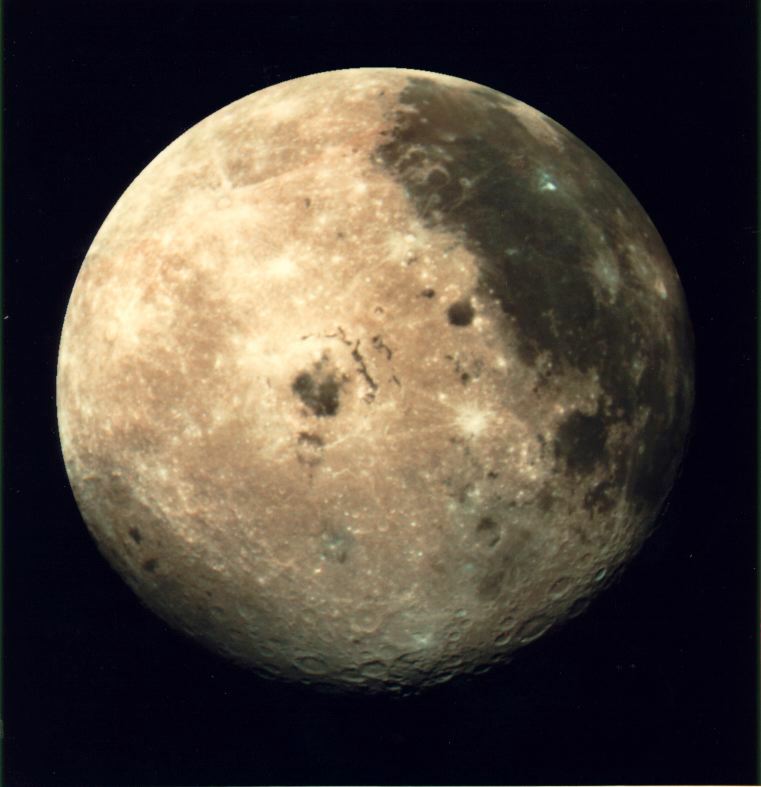|
Image Courtesy: NASA/JPL/Galileo Spacecraft
PIA00404: Moon - North Polar Mosaic, Color
Original Caption Released with Image:
During its flight, the Galileo spacecraft returned images of the Moon.
The Galileo spacecraft surveyed the Moon on December 7, 1992, on its way
to explore the Jupiter system in 1995-1997. The left part of this north
pole view is visible from Earth. This color picture is a mosaic assembled
from 18 images taken by Galileo's imaging system through a green filter.
The left part of this picture shows the dark, lava-filled Mare Imbrium
(upper left); Mare Serenitatis (middle left), Mare Tranquillitatis (lower
left), and Mare Crisium, the dark circular feature toward the bottom of
the mosaic. Also visible in this view are the dark lava plains of the Marginis
and Smythii Basins at the lower right. The Humboldtianum Basin, a 650-kilometer
(400-mile) impact structure partly filled with dark volcanic deposits,
is seen at the center of the image. The Moon's north pole is located just
inside the shadow zone, about a third of the way from the top left of the
illuminated region. The Galileo project is managed for NASA's Office of
Space Science by the Jet Propulsion Laboratory.
Credit:
NASA ~ http://photojournal.jpl.nasa.gov/catalog/PIA00404
|
|
Image Courtesy: NASA/JPL/Galileo Spacecraft
PIA00405: Moon
Original Caption Released with Image:
During its flight, the Galileo spacecraft returned images of the Moon.
The Galileo spacecraft took these images on December 7, 1992 on its way
to explore the Jupiter system in 1995-97. The distinct bright ray crater
at the bottom of the image is the Tycho impact basin. The dark areas are
lava rock filled impact basins: Oceanus Procellarum (on the left), Mare
Imbrium (center left), Mare Serenitatis and Mare Tranquillitatis (center),
and Mare Crisium (near the right edge). This picture contains images through
the Violet, 756 nm, 968 nm filters. The color is 'enhanced' in the sense
that the CCD camera is sensitive to near infrared wavelengths of light
beyond human vision. The Galileo project is managed for NASA's Office of
Space Science by the Jet Propulsion Laboratory.
Credit:
NASA ~ http://photojournal.jpl.nasa.gov/catalog/PIA00405
|
| Credits: This is a three-filter color image of the
Moon on December 9, 1990. (Courtesy of NASA)
PUBLIC INFORMATION OFFICE; JET PROPULSION LABORATORY
CALIFORNIA INSTITUTE OF TECHNOLOGY; NATIONAL AERONAUTICS AND SPACE
ADMINISTRATION
PASADENA, CALIF. 91109. TELEPHONE (818) 354-5011
PHOTO CAPTION TOP P-37329 12/19/90 GLL-EM6 SSI
This color image of the Moon was taken by the Galileo
spacecraft at 9:35 a.m. PST Dec. 9, 1990, at a range of about 350,000 miles.
The color composite uses monochrome images taken through violet, red, and
near-infrared filters. The concentric, circular Orientale basin, 600 miles
across, is near the center; the near side is to the right, the far side
to the left. At the upper right is the large, dark Oceanus Procellarum;
below it is the smaller Mare Humorum. These, like the small dark Mare Orientale
in the center of the basin, formed over 3 billion years ago as basaltic
lava flows. At the lower left, among the southern cratered highlands of
the far side, is the South-Pole-Aitken basin, similar to Orientale but
twice as great in diameter and much older and more degraded by cratering
and weathering. The cratered highlands of the near and far sides and the
Maria are covered with scattered bright, young ray craters.
http://nssdc.gsfc.nasa.gov/photo_gallery/photogallery-moon.html
|



